InSAR Reveals Coseismic Deformation and Coulomb Stress Changes of the 2025 Tingri Earthquake: Implications for Regional Hazard Assessment
Abstract
1. Introduction
2. Tectonic Setting
3. InSAR Data and Coseismic Displacement
4. Fault Model from InSAR Inversion with the Bayesian Method
4.1. Data Pre-Processing and Inversion Strategy
4.2. Uniform Slip Inversion
4.3. Slip Distribution Inversion
5. Coulomb Stress Change Models
6. Discussion
6.1. Coherence Loss in Near-Field D-InSAR Observations
6.2. Fault Inversion Results and Deep Slip Phenomenon
6.3. Improved Model Fit with a Conjugate Fault System and Analysis of Near-Field Residuals
6.4. Comparison with Other Models: Similarities and Differences
6.5. Seismogenic Mechanism and Regional Tectonics
6.6. Paired General-Shear (PGS) Deformation: Implications for Fault Evolution
7. Conclusions
- The deformation field exhibits a butterfly shaped pattern (N-S ~160 km × E-W ~100 km), consistent with normal faulting. The ascending track shows maximum LOS displacements of +0.359 m and −0.841 m, while the descending track records +0.756 m and −1.09 m, respectively.
- Inversion identifies the seismogenic fault striking 183° (near N-S) with dip/slip angles of 42.5°/−114.94°. The maximum slip (5.36 m at shallow depth) yields a seismic moment of 3.32 × 1019 N·m (MW 7.12), confirming a normal-faulting event with surface rupture. The model achieves 81% fitting accuracy.
- The 2025 Tingri Mw 7.16 earthquake induced pronounced Coulomb stress perturbations across the Himalayan orogenic belt, characterized by distinct stress reduction along the eastern and western flanks of the DMCF, while triggering significant stress accumulation (ΔCFS > 0.1 bar) in several critical fault segments—notably the eastern STDS, southern Nongqu Fault, southwestern DMCF, and central Dajiling–Angren–Renbu Fault. Particularly intense stress loading was observed within the central rupture segment of the DMCF and its junction with the southern Nongqu Fault, where the combined effect of coseismic slip and geometric complexity generated localized stress concentrations exceeding 0.3 bar. These mechanically loaded fault segments now represent high-probability zones for future seismic activity, necessitating implementation of enhanced monitoring protocols including dense GNSS arrays, frequent InSAR acquisitions, and real-time seismic network optimization to better constrain the evolving seismic hazard potential.
- Based on our analysis, this study demonstrates that the coseismic rupture of this earthquake, characterized by its normal faulting mechanism and slip distribution, is a direct manifestation of the persistent N-S compressional and E-W extensional stress regime inherent to this tectonic domain.
Supplementary Materials
Author Contributions
Funding
Data Availability Statement
Acknowledgments
Conflicts of Interest
Abbreviations
| SAR | Synthetic aperture radar |
| LOS | Line-of-sight |
| PGS | Paired general-shear |
| DMCF | Dengmecuo Fault |
| MFT | Main Frontal Thrust |
| MBT | Main Boundary Thrust |
| MCT | Main Central Thrust |
| STDS | Southern Tibetan Detachment System |
| YTSZ | Yarlung Tsangpo Suture Zone |
| GCMT | the Global Centroid Moment Tensor |
| USGS | the United States Geological Survey |
| CENC | the China Earthquake Networks Center |
| InSAR | Interferometric synthetic aperture radar |
| D-InSAR | Differential InSAR |
| COP-DEM | Copernicus Digital Elevation Model |
| GBIS | Geo-Bayesian Inversion Software |
| probability density function | |
| SDM | Steepest Descent Method |
| CFS | Coulomb failure stress |
| NF | Nongqu Fault |
| ZLQF | Zada–Lazi–Qiongdojiang Fault |
References
- Bai, L.; Chen, Z.; Wang, S. The 2025 Dingri MS6.8 Earthquake in Xizang: Analysis of Tectonic Background and Discussion of Source Characteristics. Rev. Geophys. Planet. Phys. 2025, 56, 258–263. [Google Scholar] [CrossRef]
- Shi, F.; Liang, M.; Luo, Q.; Qiao, J.; Zhang, D.; Wang, X.; Yi, W.; Zhang, J.; Zhang, Y.; Zhang, H.; et al. Seismogenic Fault and Coseismic Surface Deformation of the Dingri Ms 6.8 Earthquake in Tibet, China. Seismol. Geol. 2025, 47, 1–15. [Google Scholar] [CrossRef]
- Amey, R.M.J.; Hooper, A.; Walters, R.J. A Bayesian Method for Incorporating Self-Similarity into Earthquake Slip Inversions. J. Geophys. Res. Solid Earth 2018, 123, 6052–6071. [Google Scholar] [CrossRef]
- Bagnardi, M.; Hooper, A. Inversion of Surface Deformation Data for Rapid Estimates of Source Parameters and Uncertainties: A Bayesian Approach. Geochem. Geophys. Geosyst. 2018, 19, 2194–2211. [Google Scholar] [CrossRef]
- Wang, R.; Diao, F.; Hoechner, A. SDM—A Geodetic Inversion Code Incorporating with Layered Crust Structure and Curved Fault Geometry. In Proceedings of the EGU General Assembly Conference Abstracts, Vienna, Austria, 7–12 April 2013. [Google Scholar]
- Wang, R.; Lorenzo-Martín, F.; Roth, F. PSGRN/PSCMP—A New Code for Calculating Co- and Post-Seismic Deformation, Geoid and Gravity Changes Based on the Viscoelastic-Gravitational Dislocation Theory. Comput. Geosci. 2006, 32, 527–541. [Google Scholar] [CrossRef]
- Tapponnier, P.; Mercier, J.L.; Armijo, R.; Tonglin, H.; Ji, Z. Field Evidence for Active Normal Faulting in Tibet. Nature 1981, 294, 410–414. [Google Scholar] [CrossRef]
- Zhang, J.; Guo, L.; Ding, L. Structural Characteristics of the Central and Southern Segments of the Xainza-Dingjie Normal Fault System and Its Relationship with the Southern Tibet Detachment System. Chin. Sci. Bull. 2002, 47, 738–743. [Google Scholar] [CrossRef]
- Armijo, R.; Tapponnier, P.; Mercier, J.L.; Han, T.-L. Quaternary Extension in Southern Tibet: Field Observations and Tectonic Implications. J. Geophys. Res. Solid Earth 1986, 91, 13803–13872. [Google Scholar] [CrossRef]
- Zhao, B. Relocated Catalog of the M6.8 Tingri, Tibet Earthquake Sequence; National Earthquake Data Center: Golden, CO, USA, 2025. [CrossRef]
- Wu, X.; Xu, X.; Yu, G.; Ren, J.; Yang, X.; Chen, G.; Xu, C.; Du, K.; Huang, X.; Yang, H.; et al. The China Active Faults Database (CAFD) and Its Web System. Earth Syst. Sci. Data 2024, 16, 3391–3417. [Google Scholar] [CrossRef]
- Coleman, M.; Hodges, K. Evidence for Tibetan Plateau Uplift before 14 Myr Ago from a New Minimum Age for East–West Extension. Nature 1995, 374, 49–52. [Google Scholar] [CrossRef]
- Quidelleur, X.; Grove, M.; Lovera, O.M.; Harrison, T.M.; Yin, A.; Ryerson, F.J. Thermal Evolution and Slip History of the Renbu Zedong Thrust, Southeastern Tibet. J. Geophys. Res. Solid Earth 1997, 102, 2659–2679. [Google Scholar] [CrossRef]
- Ratschbacher, L.; Frisch, W.; Liu, G.; Chen, C. Distributed Deformation in Southern and Western Tibet during and after the India-Asia Collision. J. Geophys. Res. Solid Earth 1994, 99, 19917–19945. [Google Scholar] [CrossRef]
- Yin, A.; Harrison, T.M.; Murphy, M.A.; Grove, M.; Nie, S.; Ryerson, F.J.; Feng, W.X.; Le, C.Z. Tertiary Deformation History of Southeastern and Southwestern Tibet during the Indo-Asian Collision. GSA Bull. 1999, 111, 1644–1664. [Google Scholar] [CrossRef]
- Yin, A.; Harrison, T.M.; Ryerson, F.J.; Wenji, C.; Kidd, W.S.F.; Copeland, P. Tertiary Structural Evolution of the Gangdese Thrust System, Southeastern Tibet. J. Geophys. Res. Solid Earth 1994, 99, 18175–18201. [Google Scholar] [CrossRef]
- Bilham, R.; Gaur, V.K.; Molnar, P. Himalayan Seismic Hazard. Science 2001, 293, 1442–1444. [Google Scholar] [CrossRef]
- Avouac, J.-P.; Meng, L.; Wei, S.; Wang, T.; Ampuero, J.-P. Lower Edge of Locked Main Himalayan Thrust Unzipped by the 2015 Gorkha Earthquake. Nat. Geosci. 2015, 8, 708–711. [Google Scholar] [CrossRef]
- Houseman, G.; England, P. (Eds.) The Tectonic Evolution of Asia; World and Regional Geology Series; Cambridge University Press: Cambridge, UK, 1996; pp. 1–17. ISBN 978-0-521-48049-9. [Google Scholar]
- Wang, K.; Fialko, Y. Observations and Modeling of Coseismic and Postseismic Deformation Due to the 2015 Mw 7.8 Gorkha (Nepal) Earthquake. J. Geophys. Res. Solid Earth 2018, 123, 761–779. [Google Scholar] [CrossRef]
- McNamara, D.E.; Yeck, W.L.; Barnhart, W.D.; Schulte-Pelkum, V.; Bergman, E.; Adhikari, L.B.; Dixit, A.; Hough, S.E.; Benz, H.M.; Earle, P.S. Source Modeling of the 2015 Mw 7.8 Nepal (Gorkha) Earthquake Sequence: Implications for Geodynamics and Earthquake Hazards. Tectonophysics 2017, 714–715, 21–30. [Google Scholar] [CrossRef]
- Bai, L.; Klemperer, S.L.; Mori, J.; Karplus, M.S.; Ding, L.; Liu, H.; Li, G.; Song, B.; Dhakal, S. Lateral Variation of the Main Himalayan Thrust Controls the Rupture Length of the 2015 Gorkha Earthquake in Nepal. Sci. Adv. 2019, 5, eaav0723. [Google Scholar] [CrossRef]
- Chen, Y.; Li, W.; Yuan, X.; Badal, J.; Teng, J. Tearing of the Indian Lithospheric Slab beneath Southern Tibet Revealed by SKS-Wave Splitting Measurements. Earth Planet. Sci. Lett. 2015, 413, 13–24. [Google Scholar] [CrossRef]
- England, P.; Houseman, G. Extension during Continental Convergence, with Application to the Tibetan Plateau. J. Geophys. Res. Solid Earth 1989, 94, 17561–17579. [Google Scholar] [CrossRef]
- Lee, J.; Whitehouse, M.J. Onset of Mid-Crustal Extensional Flow in Southern Tibet: Evidence from U/Pb Zircon Ages. Geology 2007, 35, 45–48. [Google Scholar] [CrossRef]
- Li, J.; Song, X. Tearing of Indian Mantle Lithosphere from High-Resolution Seismic Images and Its Implications for Lithosphere Coupling in Southern Tibet. Proc. Natl. Acad. Sci. USA 2018, 115, 8296–8300. [Google Scholar] [CrossRef]
- Molnar, P.; Tapponnier, P. Active Tectonics of Tibet. J. Geophys. Res. 1978, 83, 5361–5375. [Google Scholar] [CrossRef]
- Pei, S.; Liu, H.; Bai, L.; Liu, Y.; Sun, Q. High-Resolution Seismic Tomography of the 2015 M7.8 Gorkha Earthquake, Nepal: Evidence for the Crustal Tearing of the Himalayan Rift. Geophys. Res. Lett. 2016, 43, 9045–9052. [Google Scholar] [CrossRef]
- Tian, X.; Chen, Y.; Tseng, T.-L.; Klemperer, S.L.; Thybo, H.; Liu, Z.; Xu, T.; Liang, X.; Bai, Z.; Zhang, X.; et al. Weakly Coupled Lithospheric Extension in Southern Tibet. Earth Planet. Sci. Lett. 2015, 430, 171–177. [Google Scholar] [CrossRef]
- Zhang, H.; Li, Y.E.; Zhao, D.; Zhao, J.; Liu, H. Formation of Rifts in Central Tibet: Insight from P Wave Radial Anisotropy. J. Geophys. Res. Solid Earth 2018, 123, 8827–8841. [Google Scholar] [CrossRef]
- Ryder, I.; Bürgmann, R.; Fielding, E. Static Stress Interactions in Extensional Earthquake Sequences: An Example from the South Lunggar Rift, Tibet. J. Geophys. Res. Solid Earth 2012, 117, 2012JB009365. [Google Scholar] [CrossRef]
- Aitchison, J.C.; Ali, J.R.; Davis, A.M. When and Where Did India and Asia Collide? J. Geophys. Res. Solid Earth 2007, 112, B05423. [Google Scholar] [CrossRef]
- Bettinelli, P.; Avouac, J.-P.; Flouzat, M.; Jouanne, F.; Bollinger, L.; Willis, P.; Chitrakar, G.R. Plate Motion of India and Interseismic Strain in the Nepal Himalaya from GPS and DORIS Measurements. J Geod. 2006, 80, 567–589. [Google Scholar] [CrossRef]
- Chen, Q.; Freymueller, J.T.; Wang, Q.; Yang, Z.; Xu, C.; Liu, J. A Deforming Block Model for the Present-Day Tectonics of Tibet. J. Geophys. Res. Solid Earth 2004, 109, B01403. [Google Scholar] [CrossRef]
- Wang, H.; Wright, T.J.; Liu-Zeng, J.; Peng, L. Strain Rate Distribution in South-Central Tibet from Two Decades of InSAR and GPS. Geophys. Res. Lett. 2019, 46, 5170–5179. [Google Scholar] [CrossRef]
- Wang, H.; Liu, M.; Cao, J.; Shen, X.; Zhang, G. Slip Rates and Seismic Moment Deficits on Major Active Faults in Mainland China. J. Geophys. Res. Solid Earth 2011, 116, B02405. [Google Scholar] [CrossRef]
- Xu, X. Late Quaternary Activity and Its Environmental Effects of the N-S Trend Kharta Fault in Xainza-Dinggye Rift, Southern Tibet. Master’s Thesis, China Earthquake Administration Institute of Geology, Beijing, China, 2019. [Google Scholar]
- He, P.; Wen, Y.; Ding, K.; Xu, C. Normal Faulting in the 2020 Mw 6.2 Yutian Event: Implications for Ongoing E–W Thinning in Northern Tibet. Remote Sens. 2020, 12, 3012. [Google Scholar] [CrossRef]
- Lasserre, C.; Peltzer, G.; Crampé, F.; Klinger, Y.; Van der Woerd, J.; Tapponnier, P. Coseismic Deformation of the 2001 M = 7.8 Kokoxili Earthquake in Tibet, Measured by Synthetic Aperture Radar Interferometry. J. Geophys. Res. Solid Earth 2005, 110, B12408. [Google Scholar] [CrossRef]
- Li, K.; Li, Y.; Tapponnier, P.; Xu, X.; Li, D.; He, Z. Joint InSAR and Field Constraints on Faulting during the Mw 6.4, July 23, 2020, Nima/Rongma Earthquake in Central Tibet. J. Geophys. Res. Solid Earth 2021, 126, e2021JB022212. [Google Scholar] [CrossRef]
- Wang, S.; Xu, C.; Wen, Y.; Yin, Z.; Jiang, G.; Fang, L. Slip Model for the 25 November 2016 Mw 6.6 Aketao Earthquake, Western China, Revealed by Sentinel-1 and ALOS-2 Observations. Remote Sens. 2017, 9, 325. [Google Scholar] [CrossRef]
- Fialko, Y.; Simons, M.; Agnew, D. The Complete (3-D) Surface Displacement Field in the Epicentral Area of the 1999 MW7.1 Hector Mine Earthquake, California, from Space Geodetic Observations. Geophys. Res. Lett. 2001, 28, 3063–3066. [Google Scholar] [CrossRef]
- Massonnet, D.; Rossi, M.; Carmona, C.; Adragna, F.; Peltzer, G.; Feigl, K.; Rabaute, T. The Displacement Field of the Landers Earthquake Mapped by Radar Interferometry. Nature 1993, 364, 138–142. [Google Scholar] [CrossRef]
- Qiu, J.; Ji, L.; Liu, L.; Liu, C. InSAR Coseismic Deformation and Tectonic Implications for the 2020 MW6.3 Nima Earthquake in Xizang. Seismol. Geol. 2021, 43, 1586–1599. [Google Scholar] [CrossRef]
- Okada, Y. Surface Deformation Due to Shear and Tensile Faults in a Half-Space. Bull. Seismol. Soc. Am. 1985, 75, 1135–1154. [Google Scholar] [CrossRef]
- Chen, T.; Akciz, S.O.; Hudnut, K.W.; Zhang, D.Z.; Stock, J.M. Fault-Slip Distribution of the 1999 Mw 7.1 Hector Mine Earthquake, California, Estimated from Postearthquake Airborne LiDAR Data. Bull. Seismol. Soc. Am. 2015, 105, 776–790. [Google Scholar] [CrossRef]
- Fukahata, Y.; Wright, T.J. A Non-Linear Geodetic Data Inversion Using ABIC for Slip Distribution on a Fault with an Unknown Dip Angle. Geophys. J. Int. 2008, 173, 353–364. [Google Scholar] [CrossRef]
- Jónsson, S.; Zebker, H.; Segall, P.; Amelung, F. Fault Slip Distribution of the 1999 Mw 7.1 Hector Mine, California, Earthquake, Estimated from Satellite Radar and GPS Measurements. Bull. Seismol. Soc. Am. 2002, 92, 1377–1389. [Google Scholar] [CrossRef]
- Laske, G.; Masters, G.; Ma, Z.; Pasyanos, M.E. CRUST1.0: An Updated Global Model of Earth’s Crust. Eur. Geosci. Union Gen. Assem. 2012, 14, 743. [Google Scholar]
- Milne, J. The California Earthquake of April 18, 1906. Nature 1910, 84, 165–166. [Google Scholar] [CrossRef]
- King, G.C.P.; Stein, R.S.; Lin, J. Static Stress Changes and the Triggering of Earthquakes. Bull. Seismol. Soc. Am. 1994, 84, 935–953. [Google Scholar] [CrossRef]
- Toda, S.; Stein, R.S.; Richards-Dinger, K.; Bozkurt, S.B. Forecasting the Evolution of Seismicity in Southern California: Animations Built on Earthquake Stress Transfer. J. Geophys. Res. Solid Earth 2005, 110, B05S16. [Google Scholar] [CrossRef]
- Shi, Y.; Cao, J. Some Aspects in Static Stress Change Calculation—Case Study on Wenchuan Earthquake. Chin. J. Geophys. 2010, 53, 102–110. [Google Scholar] [CrossRef]
- Yang, J.; Jin, M.; Ye, B.; Li, Z.; Li, Q. Source Rupture Mechanism and Stress Changes to the Adjacent Area of January 7, 2025, MS 6.8 Dingri Earthquak. Seismol. Geol. 2025, 47, 36. [Google Scholar] [CrossRef]
- Liu, Q.; Hua, J.; Zhang, Y.; Gong, W.; Zang, J.; Zhang, G.; Li, H. Geodetic Observations and Seismogenic Structures of the 2025 Mw 7.0 Dingri Earthquake: The Largest Normal Faulting Event in the Southern Tibet Rift. Remote Sens. 2025, 17, 1096. [Google Scholar] [CrossRef]
- Tian, T.; Wu, Z. Recent Prehistoric Major Earthquake Event of Dingmucuo Normal Fault in the Southern Segment of Shenzha-Dingjie Rift and Its Seismic Geological Significance. Geol. Rev. 2023, 69, 53–55. [Google Scholar] [CrossRef]
- Yu, S.; Zhang, S.; Luo, J.; Li, Z.; Ding, J. The Tectonic Significance of the Mw7.1 Earthquake Source Model in Tibet in 2025 Constrained by InSAR Data. Remote Sens. 2025, 17, 936. [Google Scholar] [CrossRef]
- Xu, X.; Wang, S.; Cheng, J.; Wu, X. Shaking the Tibetan Plateau: Insights from the Mw 7.1 Dingri Earthquake and Its Implications for Active Fault Mapping and Disaster Mitigation. npj Nat. Hazards 2025, 2, 16. [Google Scholar] [CrossRef]
- Yao, J.; Yao, D.; Chen, F.; Zhi, M.; Sun, L.; Wang, D. A Preliminary Catalog of Early Aftershocks Following the 7 January 2025 MS6.8 Dingri, Xizang Earthquake. J. Earth Sci. 2025, 36, 856–860. [Google Scholar] [CrossRef]
- Qiao, X.; Lu, Z.; Yan, S.; Shi, H.; Zhi, M.; Zhao, D. The 2025 MW7.0 Dingri Earthquake: Conjugate Normal Faulting of a Graben Structure in the Southern Xainza-Dinggye Rift. Geophys. Res. Lett. 2025, 52, e2025GL116154. [Google Scholar] [CrossRef]
- Pietrolungo, F.; Lavecchia, G.; Madarieta-Txurruka, A.; Sparacino, F.; Srivastava, E.; Cirillo, D.; de Nardis, R.; Andrenacci, C.; Bello, S.; Parrino, N.; et al. Comparison of Crustal Stress and Strain Fields in the Himalaya–Tibet Region: Geodynamic Implications. Remote Sens. 2024, 16, 4765. [Google Scholar] [CrossRef]
- Yin, A.; Taylor, M.H. Mechanics of V-Shaped Conjugate Strike-Slip Faults and the Corresponding Continuum Mode of Continental Deformation. GSA Bull. 2011, 123, 1798–1821. [Google Scholar] [CrossRef]
- Walbert, O.L.; Hetland, E.A. Bayesian Inference of Seismogenic Stress for the 2016 Mw 7.8 Kaikōura, New Zealand, Earthquake. Bull. Seismol. Soc. Am. 2022, 112, 1894–1907. [Google Scholar] [CrossRef]
- Szymanski, E.D.; Hetland, E.A.; Figueiredo, P.M. Imaging Left-lateral and Reverse Near-surface Slip of the 2020 Mw 5.1 Sparta, North Carolina, Earthquake. Bull. Seismol. Soc. Am. 2024, 114, 1870–1883. [Google Scholar] [CrossRef]

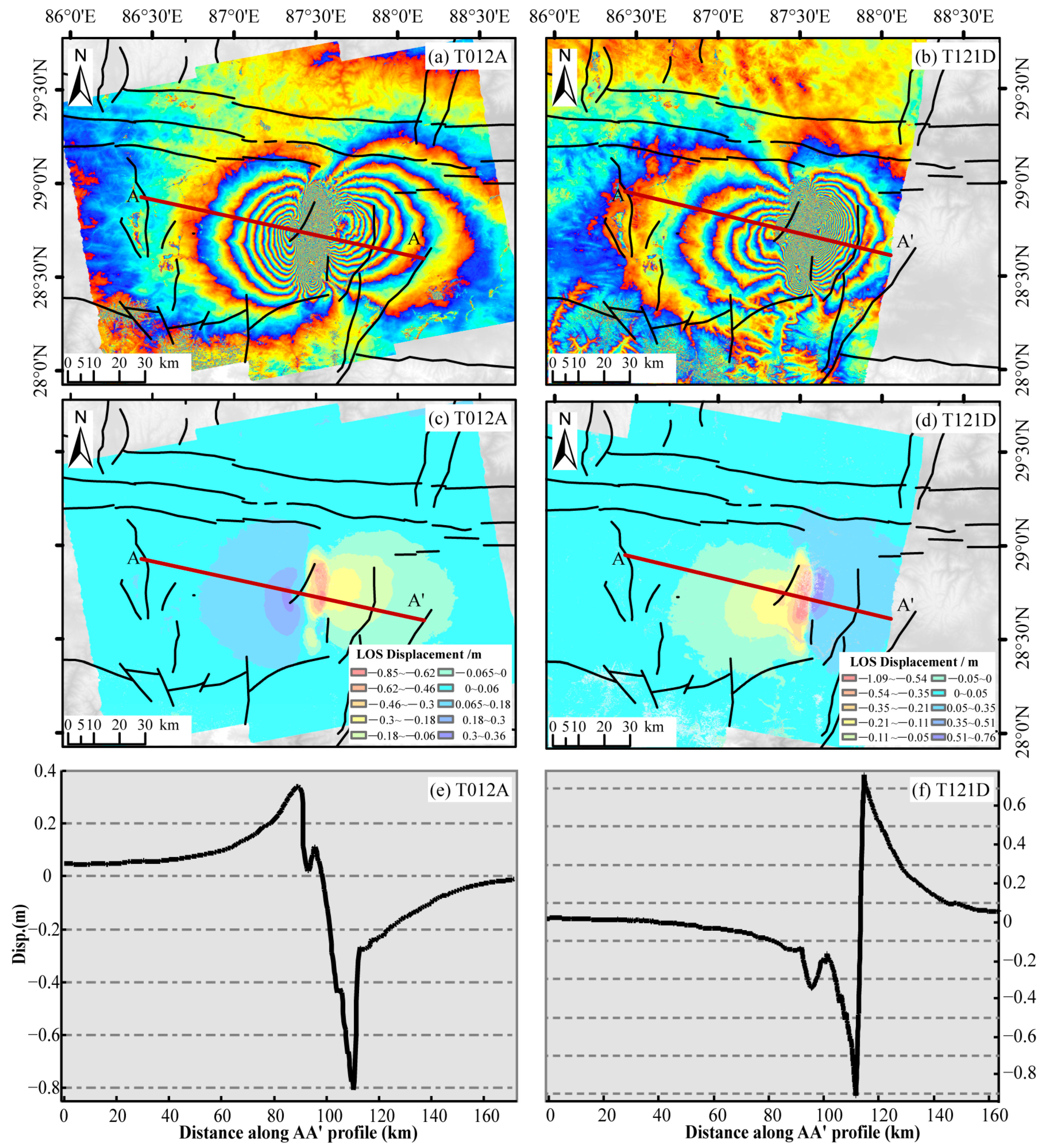
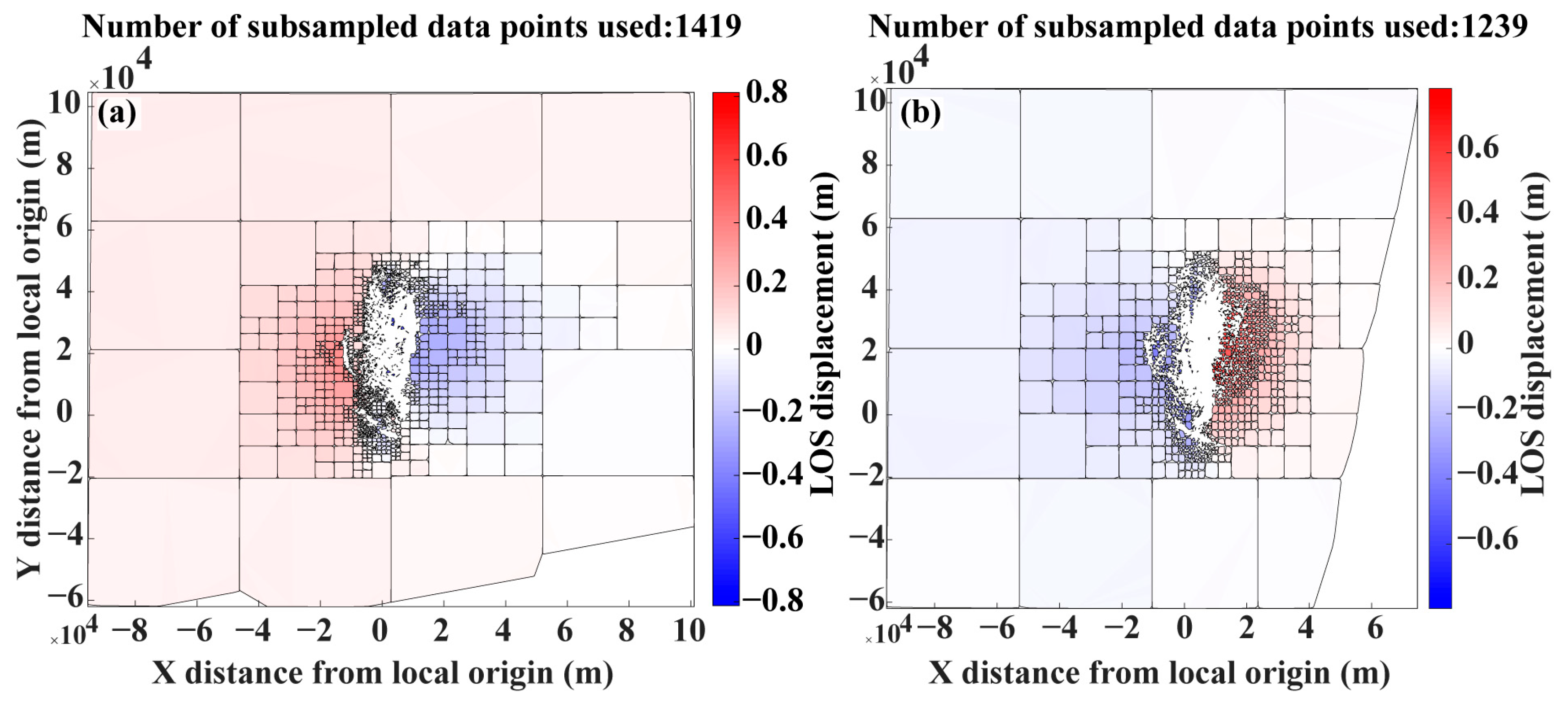

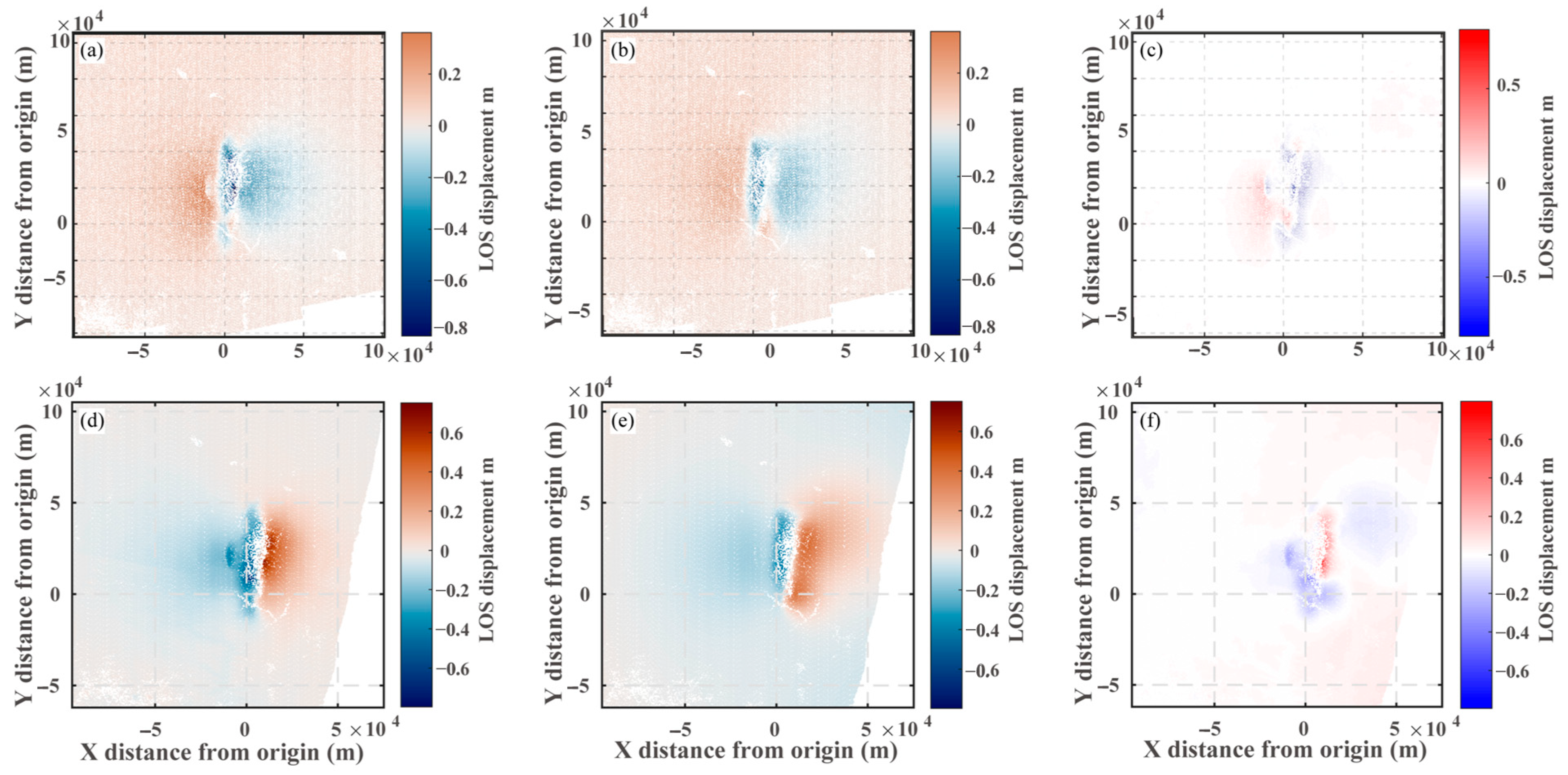

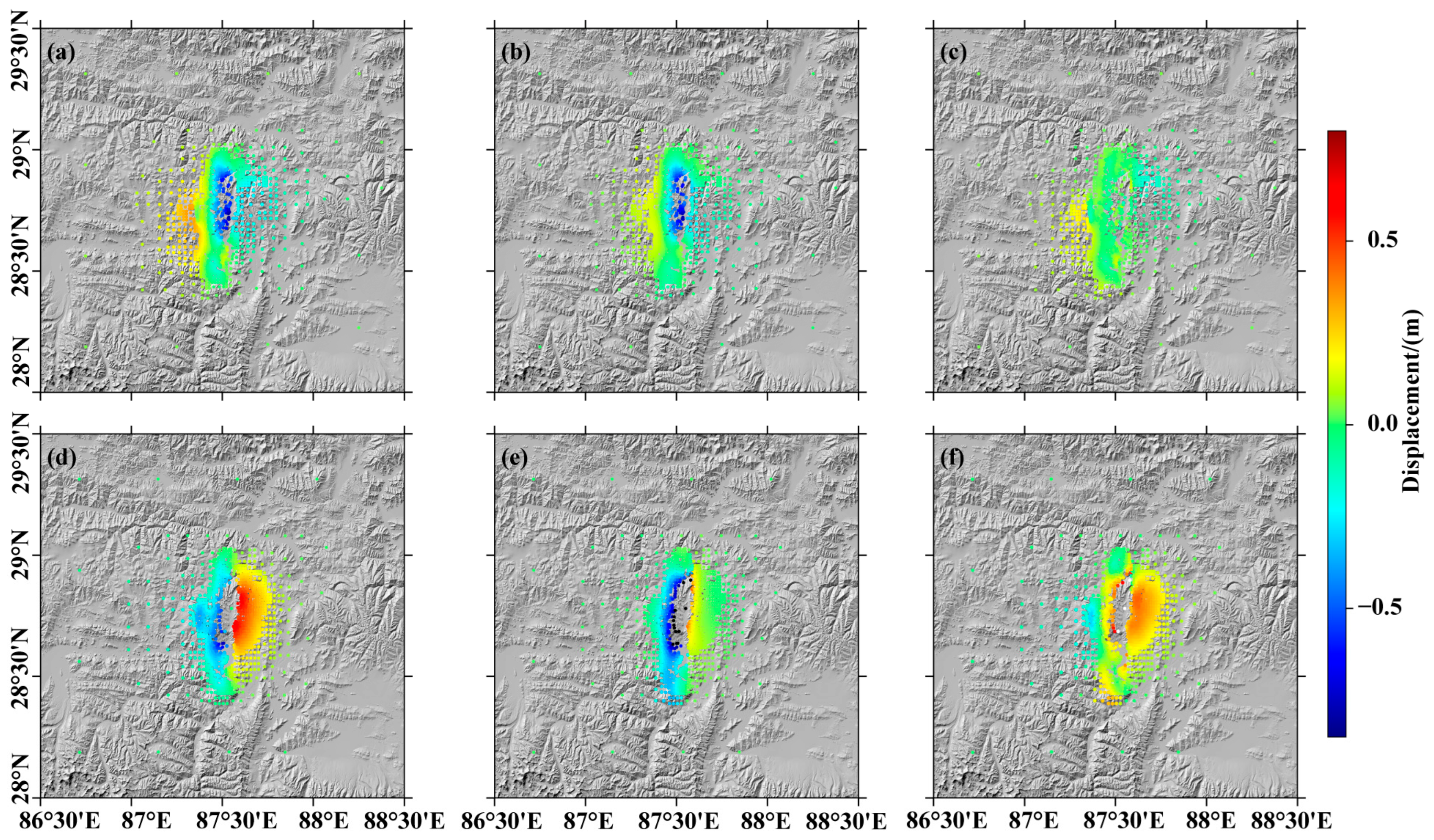
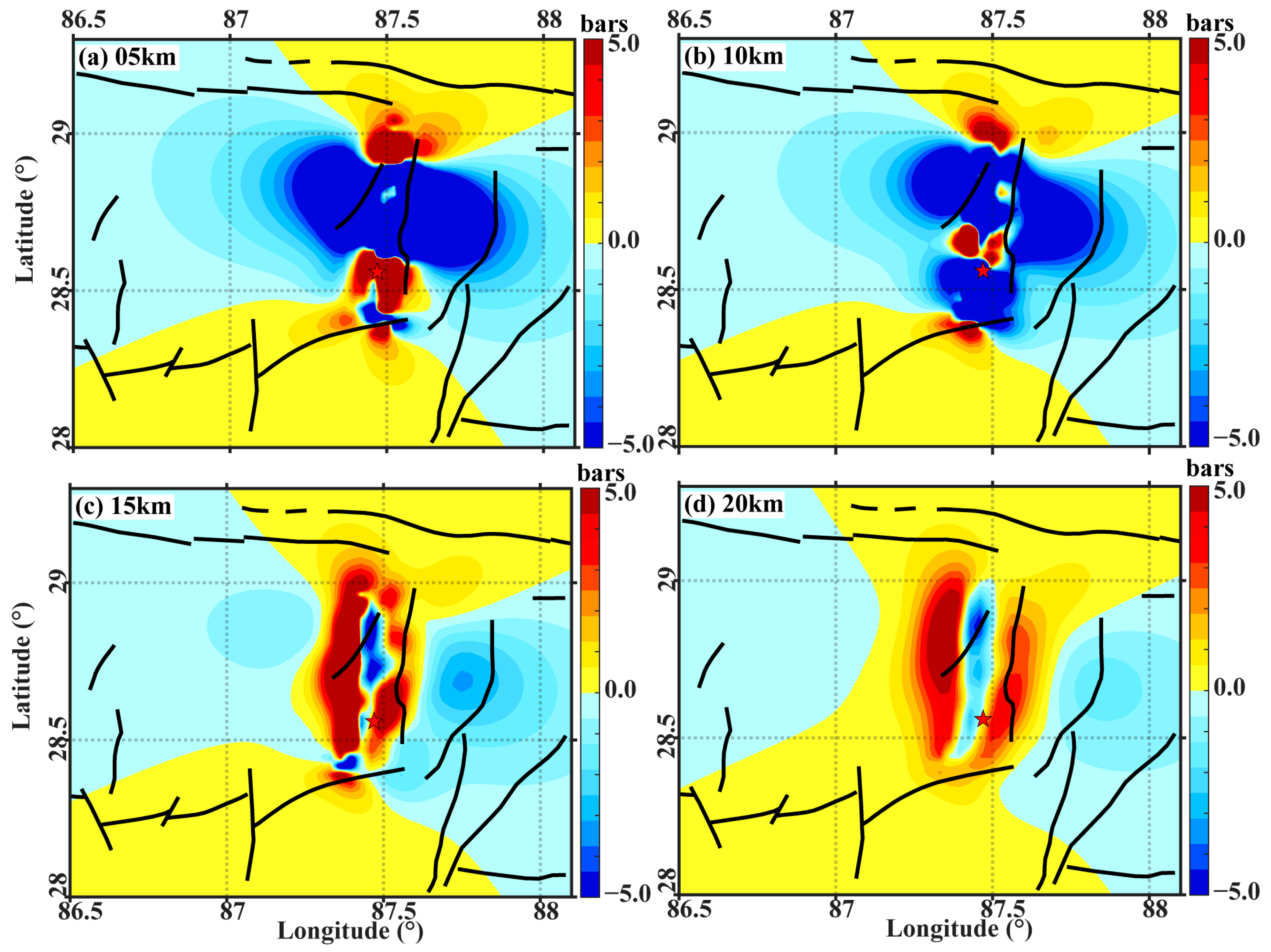
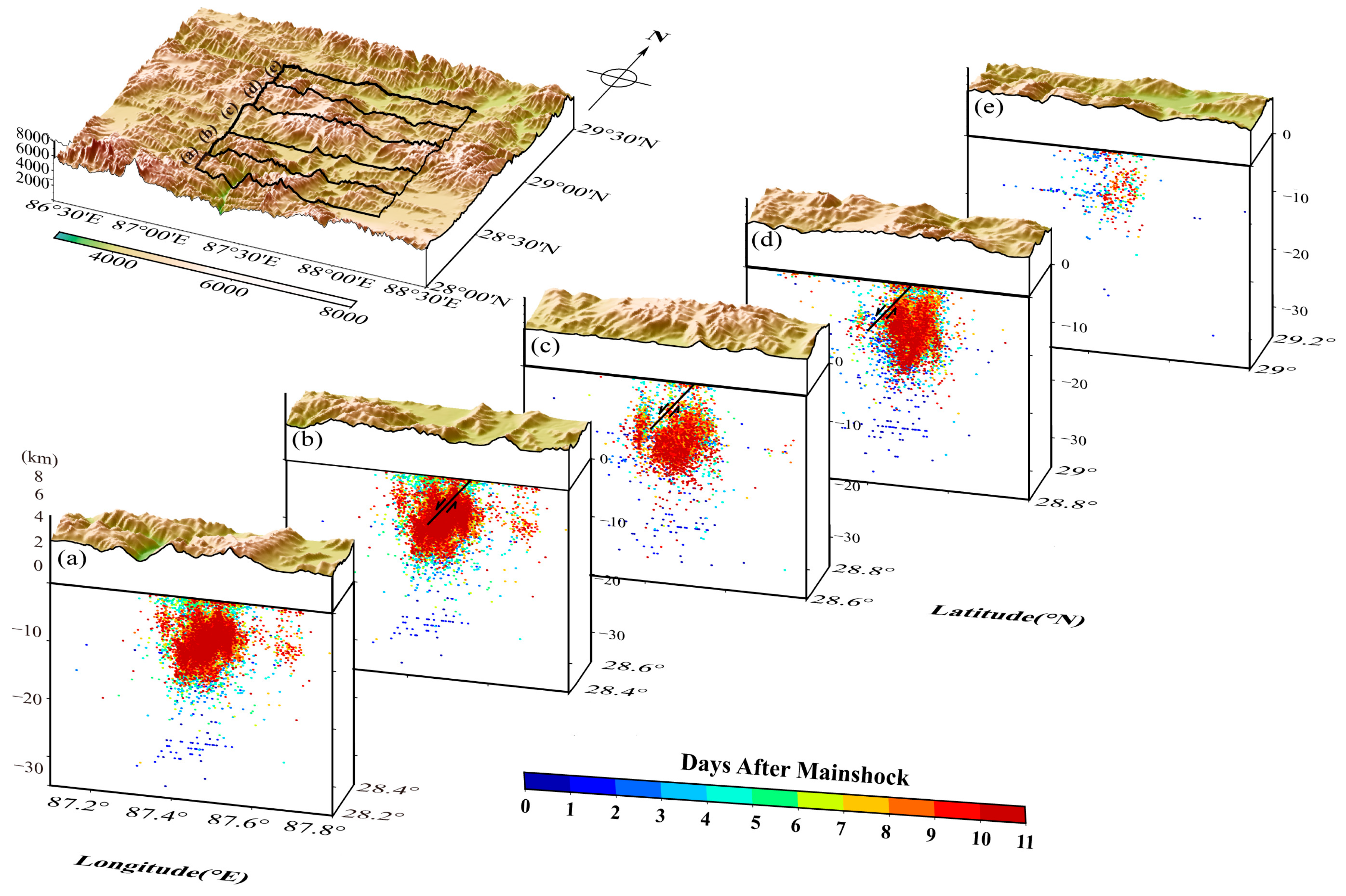
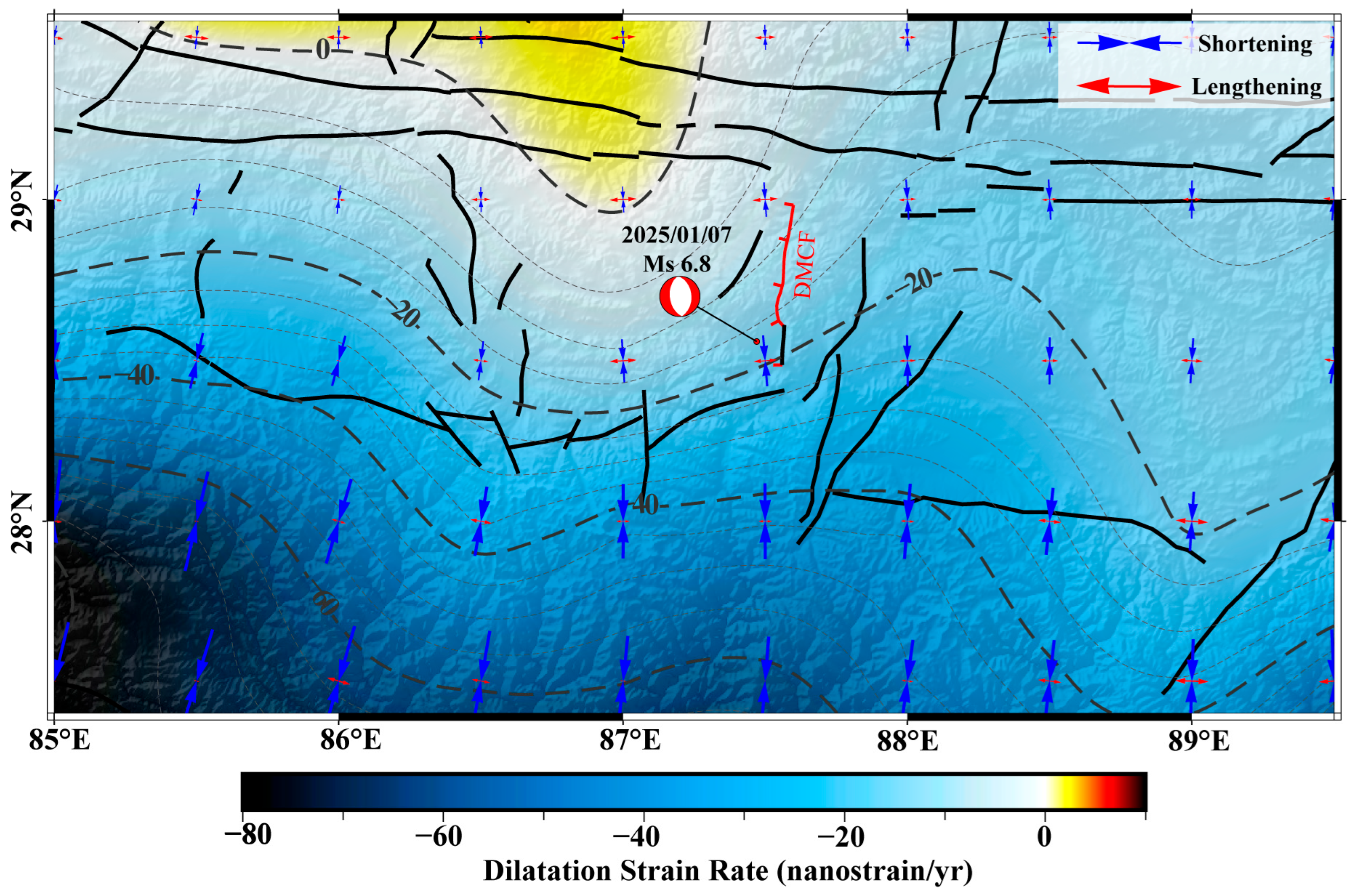
| Model | Long. | Lat | Depth | Strike | Dip | Rake | Moment | MW/MS |
|---|---|---|---|---|---|---|---|---|
| (°) | (°) | (km) | (°) | (°) | (°) | 1019N⋅m | ||
| GCMT 1 | 87.47 | 28.56 | 12 | 356 | 42 | −88 | 5.29 | 7.1 |
| 173 | 48 | −92 | ||||||
| USGS 2 | 87.378 | 28.604 | 10 | 349 | 42 | −103 | 4.749 | 7.1 |
| 187 | 49 | −78 | ||||||
| CENC 3 | 87.33 | 28.59 | 15 | 348 | 40 | −100 | — | 6.8 |
| 181 | 51 | −81 |
| Satellite | Track | Frame | Reference Date | Secondary Date | Perpendicular Baseline/m |
|---|---|---|---|---|---|
| Sentinel-1A | T012A | 89 | 5 January 2025 | 17 January 2025 | 53.2401 |
| Sentinel-1A | T121D | 493 | 1 January 2025 | 13 January 2025 | −14.7766 |
| T121D | 499 | 1 January 2025 | 13 January 2025 | −15.1536 |
| Length | Width | Depth | Dip | Strike | X Center | Y Center | |
|---|---|---|---|---|---|---|---|
| (m) | (m) | (m) | (°) | (°) | (m) | (m) | |
| Lower 1 | 35,000 | 14,000 | 4500 | −69.9 | 0 | −25,000 | −20,000 |
| Upper 1 | 80,000 | 45,000 | 15,000 | −40 | 360 | 20,000 | 30,000 |
| Optimal 2 | 36,034.8 | 14,001.3 | 6022.02 | −42.5039 | 183.127 | 1050.07 | 26,132.1 |
| 2.5% 3 | 35,860.7 | 14,000.1 | 5967.88 | −43.12 | 182.864 | 1008.6 | 26,004.9 |
| 97.5% 3 | 36,262.7 | 14,010.5 | 6076.12 | −41.9981 | 183.276 | 1090 | 26,248.8 |
| Layer: Depth Range/km | VP/km∙s−1 | VS/km∙s−1 | Density/kg∙m−3 |
|---|---|---|---|
| 0.00–4.89 | 6.00 | 3.52 | 2720 |
| 4.89–34.49 | 6.30 | 3.68 | 2790 |
| 34.49–51.45 | 6.60 | 3.82 | 2850 |
| 51.45–64.09 | 8.36 | 4.63 | 3420 |
| Fault Name | Strike/° | Dip/° | Rake/° | Effective Friction Coefficient | Poisson’s Ratio |
|---|---|---|---|---|---|
| DMCF | 183.1 | 42.5 | −114.9 | 0.4 | 0.25 |
Disclaimer/Publisher’s Note: The statements, opinions and data contained in all publications are solely those of the individual author(s) and contributor(s) and not of MDPI and/or the editor(s). MDPI and/or the editor(s) disclaim responsibility for any injury to people or property resulting from any ideas, methods, instructions or products referred to in the content. |
© 2025 by the authors. Published by MDPI on behalf of the International Society for Photogrammetry and Remote Sensing. Licensee MDPI, Basel, Switzerland. This article is an open access article distributed under the terms and conditions of the Creative Commons Attribution (CC BY) license (https://creativecommons.org/licenses/by/4.0/).
Share and Cite
Chen, A.; Wu, Z.; Zhang, H.; Wu, J.; Ping, Z.; Liao, J. InSAR Reveals Coseismic Deformation and Coulomb Stress Changes of the 2025 Tingri Earthquake: Implications for Regional Hazard Assessment. ISPRS Int. J. Geo-Inf. 2025, 14, 430. https://doi.org/10.3390/ijgi14110430
Chen A, Wu Z, Zhang H, Wu J, Ping Z, Liao J. InSAR Reveals Coseismic Deformation and Coulomb Stress Changes of the 2025 Tingri Earthquake: Implications for Regional Hazard Assessment. ISPRS International Journal of Geo-Information. 2025; 14(11):430. https://doi.org/10.3390/ijgi14110430
Chicago/Turabian StyleChen, Anan, Zhen Wu, Huiwen Zhang, Jianjian Wu, Zifei Ping, and Jiayan Liao. 2025. "InSAR Reveals Coseismic Deformation and Coulomb Stress Changes of the 2025 Tingri Earthquake: Implications for Regional Hazard Assessment" ISPRS International Journal of Geo-Information 14, no. 11: 430. https://doi.org/10.3390/ijgi14110430
APA StyleChen, A., Wu, Z., Zhang, H., Wu, J., Ping, Z., & Liao, J. (2025). InSAR Reveals Coseismic Deformation and Coulomb Stress Changes of the 2025 Tingri Earthquake: Implications for Regional Hazard Assessment. ISPRS International Journal of Geo-Information, 14(11), 430. https://doi.org/10.3390/ijgi14110430






